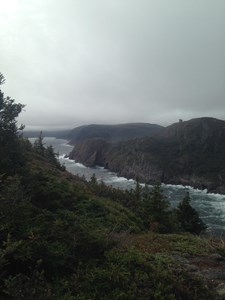"I had not dreamed of studying abroad for long, but when I realized the possibilities of an exchange period abroad, I immediately knew that I wanted to go north or somewhere by the seaside. Memorial University of Newfoundland and the city of St. John’s were both. To be honest, MUN was not the first university in Canada I found, but after some research, I liked the idea of going there.
In recent years, I have found new appreciation towards the nature of Finland (my home country) and Scandinavia. For my exchange I wanted to go somewhere further, but still, the northern island and the most eastern city in North America felt familiar enough.
Even from the plane I saw that the nature felt similar to northern Finland, but at the same time a bit different in an exciting way. The culture, on the other hand, caused a slight shock even though I was expecting it. The biggest difference to Finland was how everything was so loud – people talked more, music had to be played at dining halls, and the traditions of the orientation days and later the parties included a lot of loud music and shouting. It was overwhelming at first, but I got used to it and of course the experience was relative to my previous (rather quiet) environment. But people – both locals and other international students – were very friendly and already during the first days I knew that I would not need to fear being lonely. Both students and professors were helpful and supportive, even when the courses were challenging and the study schedule was intense.
The importance of history and closeness of nature were visible in St. John’s and at MUN campus. I happened to stay at MUN during the 100th anniversary of the ending of World War I that was visible in the street banners, at the local museum The Rooms that has a lot of exhibitions focusing on cultural and natural history of Newfoundland, and of course at the various events at Memorial University which was founded for the Newfoundlanders who served and lost their lives in the First World War. Cultural history including the fishery and island identity were also visible in my course materials, especially on a course about Canadian literature. The same course also acknowledged indigenous peoples’ culture as did MUN at official events and student groups.

Like history, nature is also close to many people in Newfoundland. There are multiple hiking trails along the coast, and there are hiking groups within and outside of the university – and for some, the hike to see the sunrise on Signal Hill (a national historic site) is just a spontaneous idea. I was lucky and found a couple of other students who wanted to explore the coast, and I went hiking with them almost every weekend until the amount of studies prevented me from having so much free time. The coast and cliffs were unlike anything I had seen so far. The constant wind that you could lean against was almost as breathtaking as the massive waves, the vastness of the ocean and the steep cliffs. Even with the wind, the place felt peaceful and I fell in love with the coast of the northern island. As the island is located by the Atlantic Ocean, it is a home and a nesting place to multiple seabirds, and the coast has numerous bird sanctuaries and reserves.
The exchange certainly changed my life. I found a new appreciation for my home university of Tampere, where I luckily have the chance to continue my literary studies about the Arctic with more deep understanding of the northern areas. Spending the fall in Newfoundland deepened my love for the northern nature and coasts. I will miss the cliffs and the ocean, but I think I will explore some other islands and coasts of the Arctic and Atlantic before returning to St. John’s."
UArctic's north2north mobility program provides opportunities to study, teach and carry out research in different parts of the North.
